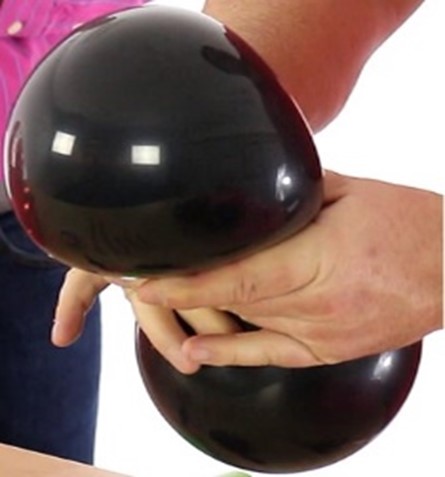Do any of these cues sound familiar to you?
“Engage your core”
“Draw your navel in”
“Core tight”
“Belly in”
“Brace your core”
If so, how many times do you find yourself using these (or similar cues) during a session or class? If you’re like the majority of fitness professionals today, you may find yourself using them quite frequently. In fact, we often hear professionals voicing these cues constantly throughout a 45-60 minute session.
This constant focus on core engagement, coupled with our societal obsession with the flat stomach has led to a pervasive habit of sucking in (or chronically holding one’s belly in a taut position). Unfortunately, this habit can lead to a host of negative consequences — especially for your pregnant and postpartum clients.
Discover how sucking in affects the body, then learn alternative cues that can help your clients develop a stronger, more functional, core.
The Impact of “Sucking In”
Breathing is the body’s “master regulator.” Everything from the nervous system, to hormonal function, blood pressure regulation, digestion, immunity, energy level, and even alignment are impacted by the way we breathe.
In order to breathe optimally, the breath must be unrestricted in three dimensions. This is what we refer to as 360° Breathing. On the inhale, the space in the abdominal cavity should expand — outward and downward. Then, on the exhale, the space gets smaller. This unrestricted expansion and contraction creates a harmonious “pumping mechanism” in the core that helps to regulate intra-abdominal pressure (IAP).
If we chronically hold our bellies in a taut position (or “suck in”), the breath can no longer expand in three dimensions. This disrupts the harmonious pumping mechanism mentioned above, and thereby creates excess intra-abdominal pressure that gets directed upward and downward. This is particularly problematic during pregnancy, when IAP is already elevated due to the growing belly.
To help you visualize this, imagine blowing up a balloon. As you blow air into the balloon, it expands in three dimensions. This is what happens during an inhale when your belly is relaxed. Now, imagine using your hands to squeeze that balloon around the middle, as in the photo below.

Note how the middle gets smaller but the top and bottom bulge outwards. That is essentially what happens when you suck in: you restrict expansion in one area but then the internal pressure gets redirected up to the chest area and down onto your pelvic floor.
Let’s look at the effects of this upward and downward pressure below.
The Negative Consequences of Sucking In
When pressure gets directed upward, it restricts the ability of the lungs to fully expand, which forces the body to figure out another way to get air in. Instead of relying on your diaphragm (which should be the body’s primary respiratory muscle), the body is forced to rely on the accessory muscles of the neck and shoulders to do the job of respiration — a task which they are not designed to do. This is known as apical breathing. In addition to leading to dysregulation in the core muscles, apical breathing can lead to higher stress levels, stiffness, movement restriction, and pain in the neck and shoulders.
When pressure gets directed downward, it increases the stress on the pelvic floor muscles (which are already under greater stress during pregnancy). The combined pressure from the accumulation of pregnancy weight gain and sucking in can often exceed the capacity of the pelvic floor muscles, which can lead to pelvic floor dysfunction, especially in pregnant and postpartum clients given the added stress that pregnancy and birth place on the pelvic floor.
Three Keys to Elicit Better Core Activation
A certain amount of core engagement is beneficial — when done correctly and in the appropriate context. So, let’s discuss the three keys to accomplishing this:
1. Engagement as a RESULT of the exhale
When we refer to “correct” core engagement, this means that the engagement comes as a result of the exhale. Drawing the navel in on the inhale can lead to IAP dysregulation. Therefore, the first move to teach your clients is 360° Breathing (a.k.a the #1 most effective core exercise). Even if you teach group fitness, and do not necessarily have the time to stop and teach your clients this movement, you can still encourage 360° Breathing by demonstrating it yourself, and using simple cues like:
“Inhale through your nose, exhale through your mouth.”
“Feel your ribcage expand as you inhale and contract as you exhale.”
Once your clients understand this basic principle, you can use more exhale-focused cues. So, instead of saying “engage your core” or “draw your navel in” (which leave out the critical guidance of the exhale), use cues to encourage exhaling (i.e. “blow up a balloon” or “blow out your birthday candles”) and then the engagement will come as a result.
2. Exhale on the Effort
When we refer to core engagement being done in the “appropriate context,” we mean that the exhale (and resulting engagement) comes during the “effort” portion of the movement, or exhale on the effort. This means that you inhale on the easier portion of the movement (typically the eccentric phase, like lowering down into a squat) and exhaling on the more challenging portion of the movement (typically the concentric phase, like standing up from the squat).
In the case of holding a plank (or similar movement), the core does remain engaged for the duration of the movement (focusing on a light inhale and strong exhale). However, that’s for a 30-60 second movement — not throughout the entire 30 – 60 minute session or class. Like everything in life, balance is key. A strong exhale must be balanced with a full, unrestricted inhale.
To help your clients get used to the idea of exhaling on the effort, it’s helpful to cue when to exhale as you explain a movement and then as your client(s) perform it as well. After sufficient practice, this should become natural, but it is helpful to cue it in the beginning to engrain the habit.
3. Match Tension to Task
One additional way to incorporate “balance” and avoid chronic tension in the belly is to remember to “match tension to task.” In other words, the greater the intensity (or stability challenge), the greater the exhale should be. For example, if you have your clients performing body weight squats, they can comfortably inhale and exhale. However, if they are performing heavy weighted squats (or holding a plank), they would need a much stronger exhale.
One More Tip: Pay Attention to Your Habits
As you read this article, did you feel perhaps that you might be guilty of chronically holding your belly in as well? Perhaps you are holding excess tension in your belly without even thinking about it. Try this tip. At various times during your day — such as when waiting in line, standing and talking, or working out — take note of if you find yourself holding in your stomach. If you find that you’re holding tension there, make a conscious effort to relax. NOTE — you may “catch yourself” doing this a lot. Don’t stress. Habits take time to change. The important thing is to bring awareness to your habits, which is certainly a step in the right direction.
Want Additional Resources?
For additional resources to help you exercise safely and effectively during pregnancy, explore our training programs and services. You’ll find a variety of offerings tailored to different needs — from education, to self-guided programs, to the ability to work with an expert coach.
Or, if you’re a health & fitness pro interested in coaching pre & postnatal clients, check out our ProNatal Education & Certification.
